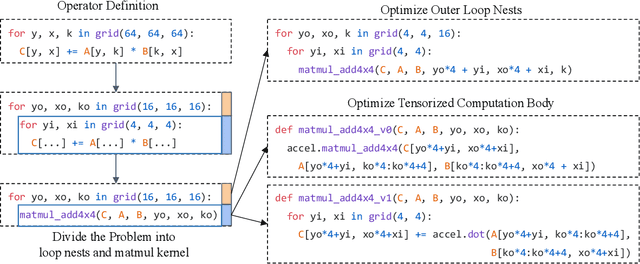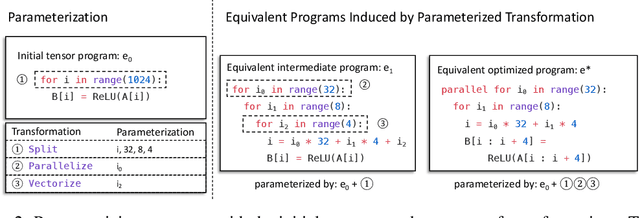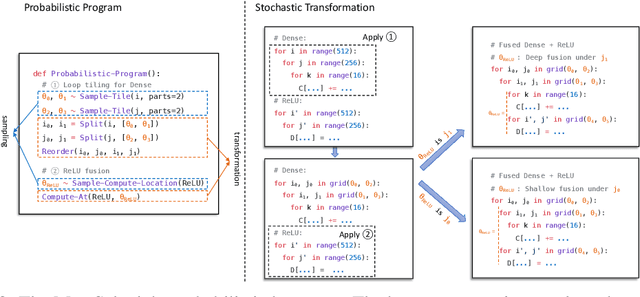Ruihang Lai
FlashInfer: Efficient and Customizable Attention Engine for LLM Inference Serving
Jan 02, 2025



Abstract:Transformers, driven by attention mechanisms, form the foundation of large language models (LLMs). As these models scale up, efficient GPU attention kernels become essential for high-throughput and low-latency inference. Diverse LLM applications demand flexible and high-performance attention solutions. We present FlashInfer: a customizable and efficient attention engine for LLM serving. FlashInfer tackles KV-cache storage heterogeneity using block-sparse format and composable formats to optimize memory access and reduce redundancy. It also offers a customizable attention template, enabling adaptation to various settings through Just-In-Time (JIT) compilation. Additionally, FlashInfer's load-balanced scheduling algorithm adjusts to dynamism of user requests while maintaining compatibility with CUDAGraph which requires static configuration. FlashInfer have been integrated into leading LLM serving frameworks like SGLang, vLLM and MLC-Engine. Comprehensive kernel-level and end-to-end evaluations demonstrate FlashInfer's ability to significantly boost kernel performance across diverse inference scenarios: compared to state-of-the-art LLM serving solutions, FlashInfer achieve 29-69% inter-token-latency reduction compared to compiler backends for LLM serving benchmark, 28-30% latency reduction for long-context inference, and 13-17% speedup for LLM serving with parallel generation.
WebLLM: A High-Performance In-Browser LLM Inference Engine
Dec 20, 2024

Abstract:Advancements in large language models (LLMs) have unlocked remarkable capabilities. While deploying these models typically requires server-grade GPUs and cloud-based inference, the recent emergence of smaller open-source models and increasingly powerful consumer devices have made on-device deployment practical. The web browser as a platform for on-device deployment is universally accessible, provides a natural agentic environment, and conveniently abstracts out the different backends from diverse device vendors. To address this opportunity, we introduce WebLLM, an open-source JavaScript framework that enables high-performance LLM inference entirely within web browsers. WebLLM provides an OpenAI-style API for seamless integration into web applications, and leverages WebGPU for efficient local GPU acceleration and WebAssembly for performant CPU computation. With machine learning compilers MLC-LLM and Apache TVM, WebLLM leverages optimized WebGPU kernels, overcoming the absence of performant WebGPU kernel libraries. Evaluations show that WebLLM can retain up to 80% native performance on the same device, with room to further close the gap. WebLLM paves the way for universally accessible, privacy-preserving, personalized, and locally powered LLM applications in web browsers. The code is available at: https://github.com/mlc-ai/web-llm.
XGrammar: Flexible and Efficient Structured Generation Engine for Large Language Models
Nov 22, 2024



Abstract:The applications of LLM Agents are becoming increasingly complex and diverse, leading to a high demand for structured outputs that can be parsed into code, structured function calls, and embodied agent commands. These developments bring significant demands for structured generation in LLM inference. Context-free grammar is a flexible approach to enable structured generation via constrained decoding. However, executing context-free grammar requires going through several stack states over all tokens in vocabulary during runtime, bringing non-negligible overhead for structured generation. In this paper, we propose XGrammar, a flexible and efficient structure generation engine for large language models. XGrammar accelerates context-free grammar execution by dividing the vocabulary into context-independent tokens that can be prechecked and context-dependent tokens that need to be interpreted during runtime. We further build transformations to expand the grammar context and reduce the number of context-independent tokens. Additionally, we build an efficient persistent stack to accelerate the context-dependent token checks. Finally, we co-design the grammar engine with LLM inference engine to overlap grammar computation with GPU executions. Evaluation results show that XGrammar can achieve up to 100x speedup over existing solutions. Combined with an LLM inference engine, it can generate near-zero overhead structure generation in end-to-end low-LLM serving.
Emerging Platforms Meet Emerging LLMs: A Year-Long Journey of Top-Down Development
Apr 14, 2024Abstract:Deploying machine learning (ML) on diverse computing platforms is crucial to accelerate and broaden their applications. However, it presents significant software engineering challenges due to the fast evolution of models, especially the recent \llmfull{s} (\llm{s}), and the emergence of new computing platforms. Current ML frameworks are primarily engineered for CPU and CUDA platforms, leaving a big gap in enabling emerging ones like Metal, Vulkan, and WebGPU. While a traditional bottom-up development pipeline fails to close the gap timely, we introduce TapML, a top-down approach and tooling designed to streamline the deployment of ML systems on diverse platforms, optimized for developer productivity. Unlike traditional bottom-up methods, which involve extensive manual testing and debugging, TapML automates unit testing through test carving and adopts a migration-based strategy for gradually offloading model computations from mature source platforms to emerging target platforms. By leveraging realistic inputs and remote connections for gradual target offloading, TapML accelerates the validation and minimizes debugging scopes, significantly optimizing development efforts. TapML was developed and applied through a year-long, real-world effort that successfully deployed significant emerging models and platforms. Through serious deployments of 82 emerging models in 17 distinct architectures across 5 emerging platforms, we showcase the effectiveness of TapML in enhancing developer productivity while ensuring model reliability and efficiency. Furthermore, we summarize comprehensive case studies from our real-world development, offering best practices for developing emerging ML systems.
Relax: Composable Abstractions for End-to-End Dynamic Machine Learning
Nov 01, 2023



Abstract:Dynamic shape computations have become critical in modern machine learning workloads, especially in emerging large language models. The success of these models has driven demand for deploying them to a diverse set of backend environments. In this paper, we present Relax, a compiler abstraction for optimizing end-to-end dynamic machine learning workloads. Relax introduces first-class symbolic shape annotations to track dynamic shape computations globally across the program. It also introduces a cross-level abstraction that encapsulates computational graphs, loop-level tensor programs, and library calls in a single representation to enable cross-level optimizations. We build an end-to-end compilation framework using the proposed approach to optimize dynamic shape models. Experimental results on large language models show that Relax delivers performance competitive with state-of-the-art hand-optimized systems across platforms and enables deployment of emerging dynamic models to a broader set of environments, including mobile phones, embedded devices, and web browsers.
SparseTIR: Composable Abstractions for Sparse Compilation in Deep Learning
Jul 11, 2022



Abstract:Sparse tensors are rapidly becoming critical components of modern deep learning workloads. However, developing high-performance sparse operators can be difficult and tedious, and existing vendor libraries cannot satisfy the escalating demands from new operators. Sparse tensor compilers simplify the development of operators, but efficient sparse compilation for deep learning remains challenging because a single sparse format cannot maximize hardware efficiency, and single-shot compilers cannot keep up with latest hardware and system advances. We show that the key to addressing both challenges is two forms of composability. In this paper, we propose SparseTIR, a sparse tensor compilation abstraction that offers composable formats and composable transformations for deep learning workloads. SparseTIR constructs a search space over these composable components for performance tuning. With these improvements, SparseTIR obtains consistent performance speedups vs vendor libraries on GPUs for single operators: 1.1-3.3x for GNN operators and 1.1-4.4x for sparse transformer operators. SparseTIR also accelerates end-to-end GNNs by 1.1-2.2x for GraphSAGE training and 0.9-26x for RGCN inference.
TensorIR: An Abstraction for Automatic Tensorized Program Optimization
Jul 09, 2022



Abstract:Deploying deep learning models on various devices has become an important topic. The wave of hardware specialization brings a diverse set of acceleration primitives for multi-dimensional tensor computations. These new acceleration primitives, along with the emerging machine learning models, bring tremendous engineering challenges. In this paper, we present TensorIR, a compiler abstraction for optimizing programs with these tensor computation primitives. TensorIR generalizes the loop nest representation used in existing machine learning compilers to bring tensor computation as the first-class citizen. Finally, we build an end-to-end framework on top of our abstraction to automatically optimize deep learning models for given tensor computation primitives. Experimental results show that TensorIR compilation automatically uses the tensor computation primitives for given hardware backends and delivers performance that is competitive to state-of-art hand-optimized systems across platforms.
Tensor Program Optimization with Probabilistic Programs
May 26, 2022



Abstract:Automatic optimization for tensor programs becomes increasingly important as we deploy deep learning in various environments, and efficient optimization relies on a rich search space and effective search. Most existing efforts adopt a search space which lacks the ability to efficiently enable domain experts to grow the search space. This paper introduces MetaSchedule, a domain-specific probabilistic programming language abstraction to construct a rich search space of tensor programs. Our abstraction allows domain experts to analyze the program, and easily propose stochastic choices in a modular way to compose program transformation accordingly. We also build an end-to-end learning-driven framework to find an optimized program for a given search space. Experimental results show that MetaSchedule can cover the search space used in the state-of-the-art tensor program optimization frameworks in a modular way. Additionally, it empowers domain experts to conveniently grow the search space and modularly enhance the system, which brings 48% speedup on end-to-end deep learning workloads.
 Add to Chrome
Add to Chrome Add to Firefox
Add to Firefox Add to Edge
Add to Edge